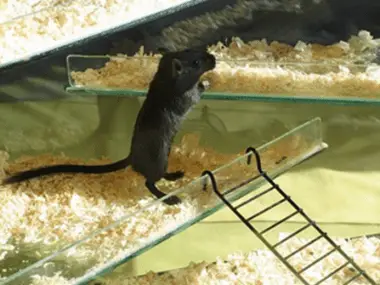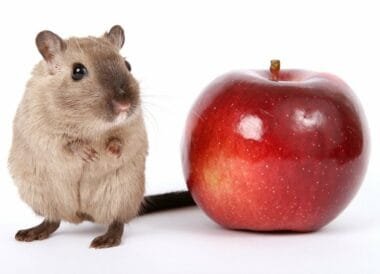Gerbils are rodents with their body sizes typically being between 150 and 300 mm. Much like Hamsters, they are small, rather easy on the pocket, and incredibly cute. Unlike Hamsters, these rodents are some of the easiest to maintain and handle. There are 110 known species of Gerbils. They mostly live in Arid or Semi-Arid areas of Africa and Asia. Though their numbers aren’t negligible, only a few species are kept as pets. The most common one is the usually golden furred Mongolian Gerbil while the Fat-tailed Gerbil (Pachyuromys duprasi), Pale Gerbil (Gerbillus perpallidus), and Shaw’s Jird (Meriones shawi) are few and far in between.
Other species such as the Great Gerbil (Rhombomys opimus) are menacing pests who destroy property and eat through everything in their path.
Whether you should get a gerbil to keep as a pet would be dependent on how well you are able to provide them with what they need. Gerbils have particular needs and wants, which you need to be able to get them. These necessities exist either due to the nature of the species or due to the peculiarities of the different breeds. For e.g. Gerbils do not do well in round tanks. They seek corners, and without this, they would be unable to sleep well, and then fall sick.
Nature and character of Gerbils
Different species or breeds of Gerbils behave differently. While some are pests, others are beloved pets. So it’s very important to know which type of rodent you’re letting into your house. The answer to how much is a Gerbil is different too, and is based on their behaviors and nature.
All Gerbils do have some common traits, that make them such beloved pets. They are also some facts to keep in mind. These facts do influence how much a gerbil costs, as well as how much it needs to be taken care of. Most pet gerbils are clean, friendly, and gentle. However, they are not suited to small children, especially without supervision as Gerbils do require special care, and can go into epileptic shocks due to rough handling.
- Common Gerbil facts
- Gerbils can, and will jump high distances. Though this natural ability should be encouraged as exercise, this habit means they are great escape artists. Their home should not be one they can easily jump out of, leaving them at the mercy of a plethora of dangerous predators. It is also important to always hold your gerbil low, near the ground near a soft place when holding them. Especially when outside their cage. It is possible that they will jump from your grip and get hurt.
- Gerbils are natural diggers. This means that they need earth to dig through. Cages with tunnels already made for hamsters and mice won’t work as Gerbils need to create their own system. They are also naturally adept at remembering tunnel systems. In the long term, if they do not have this activity, gerbils can become rather depressed.
- Gerbils are very territorial and mark their territory with scent. This means that as an owner, you have to be extremely careful with scents. While cleaning the tank, no new scents should ever make it way in. Unfamiliar scents signify that a different clan, probably aggressively, made its way into the cage. This can confuse and even scare your pet gerbils.
- A gerbil’s teeth never stop growing. This means that they need to be taken care of constantly. How gerbils do this is by chewing everything in their path. This is why there should be no plastic in their environment as they will eat it. It’s best to give them little wood or hard roots to chew on, as that is what they do in the wild. Some say that cardboard is safe as well. This keeps their ever-growing teeth in shape, and doesn’t lead them to destroy everything around them. This is also why it is probably not a great idea to build them a cage out of wood. They will definitely eat through it.
- Gerbils can get pregnant almost immediately after their birth. On top pf that, they are also able to get pregnant right after giving birth as well. Though this ensures their existence in the wild, at home it can be a problem. Technically, Gerbils can give birth to large litters every few months. Over time, this means that it is better to keep them away from the opposite sex unless you want to end up with a forest full of Gerbils.

Mongolian gerbil
The most popular amongst the masses as pet Gerbils, this breed is gentle, and yet hardy-making for an easy to care for companion. The Mongolian Gerbil was first made popular as a house pet in Paris when it was brought there from China in the 19th century. Selective breeding in the consequent centuries resulted in Mongolian Gerbils having a wide range of different color and pattern varieties
- Nature of the Mongolian Gerbil:
This breed is energetic, curious and friendly. They love exploring their surroundings. However, they keep this energy all through the day and night. The Mongolian gerbil is active almost all hours of the day, and will most certainly squeak in the night as well. If total silence is needed for you to sleep, the Mongolian Gerbil might not be your best bet for a pet.
Gerbils by nature love to chew, and this breed of the rodent are no different. They are active creatures and thus should be given the chance to dig and create their own tunnel systems. However, Mongolian Gerbils specifically are very good at digging deep tunnels. They require around 10 gallons of living space by each Gerbil as well as several layers of earth to dig through. This adds a substantial cost to having Gerbils around and is something that needs to be thought about if you think you should get a Gerbil.
- Food habits
As for food, Mongolian gerbils cannot digest fresh foods like vegetables and legumes very well. They do better with seed and pellet mixes. Though they are known to exist in arid areas, a drip-feed system is essential for their survival. Make sure to have clean water around at all times as well.
- Living situation
Another thing to keep in mind is definitely that Mongolian Gerbils are not solitary animals.These are highly social animals and live in groups when in the wild. They are wired to become depressed if left alone for long periods of time, and need company to survive. Cost wise, this means your costs for taking care of a gerbil need to be multiplied by two. Lonely Gerbils are prone to stress-induced seizures, hair fall, anorexia, and a whole host of other serious issues.
It is also better to keep two gerbils of the same sex, from the same litter together. This way, there is less of a chance of a fight breaking out. Gerbils are communal but territorial animals. Because of this, their companionship needs are very specific, and they prefer to live in groups or pairs. They do get along well, and generally do not bite.
Mongolian gerbils usually live 2-4 years.
Since Mongolian Gerbils are so widely found, vets are more familiar with Mongolian Gerbils and thus healthcare might be cheaper. They will also be very sure of what your pet needs, thus making sure that you get the very best of healthcare for your beloved pet.
Fat-Tailed Gerbils (Duprasi Gerbils)
This breed, though rare to find, might be even easier to take care of, than a Mongolian Gerbil. The main downsides of this breed are the fact that they are not sold very often. This is also the reason vets do not have a lot of experience with fat-tailed gerbils. This can possibly raise the price of both the gerbil itself and its long term healthcare. How much a Fat-tailed Gerbil is, depends on the type of breeder you get them from and if you need any specialty healthcare. These gerbils can set you back around $100, since they are usually sold by specialty breeders.
- Where they come from:
Fat-tailed Gerbils originate from Africa, and are found today in the northern Sahara desert. They were discovered in Algeria and are also known as ‘Doops.’
Their quirky name refers to the fat tail they have. It is a mechanism that protects them in the harsh geography of their natural homes. Since these rodents live in the desert of the Sahara, they evolved to hold fat and water in their tail. Their odd looking long, thick tails lacking in body hair, helps them to survive when food and water is unavailable. A healthy fat-tailed gerbil should have, as their name suggests, a fat tail. An unhealthy one will have a thin tail. This means that they are either unable to store food, or that they have been starved long enough to have no fat left.
These rodents with sizes varying between 3 inches (7.62 cm) to 5 inches (12.7 cm), have large tails that are around 2 inches (5.08 cm) long. They also weigh anything from 40gms to a 100gms. These gerbils live for about 8 years in captivity.
- Nature:
What makes this breed a terrific pet is the fact that they are even more docile than the Mongolian Gerbil. They are laid back creatures, meaning they don’t need as much attention or activities as Mongolian Gerbils do.
These slow moving rodents are also known to be Diurnal. This means that unlike the Mongolian Gerbil, the Flat Tailed gerbil sleeps at night. However, though they are active during the day, they are prone to taking frequent naps. For this, they need a dark corner where they can snuggle and sleep. For this reason, make sure to buy cages that are square and afford them ample dark corners to nap in.
Interestingly enough, flat-tailed gerbils can live without companions, though they then do need human love more. However, they do appreciate the company of their own race. The good thing about this is that you do not have to worry about not immediately getting them companions. They also love to be held, so make sure to give them lots of love.
Pale gerbil
These types of Gerbils are even rarer than the flat-tailed Gerbil. They are native to Egypt and have fur under their paws. Their fur is pale orange with a white underside. They live for about 2 to 4 years when bred in captivity.
Their needs are the same as Mongolian Gerbils, but are slightly more difficult to handle but sociable. Which is why they are better for those who already have had experience taking care of a Mongolian Gerbil.
Shaw’s Jird
Though Shaw’s Jird is a common rodent in North Africa, they are the rarest gerbils to be sold as pets. They are fairly aggressive toward each other, but are docile when handled by humans. Funnily enough, this breed become tamer than all the other breeds once they get used to their owners and other humans. The females of Shaw’s Jird are extremely territorial and unlike the Mongolian Gerbils, will attack the other. However, they almost never bite humans unless they are being extremely aggressive.









